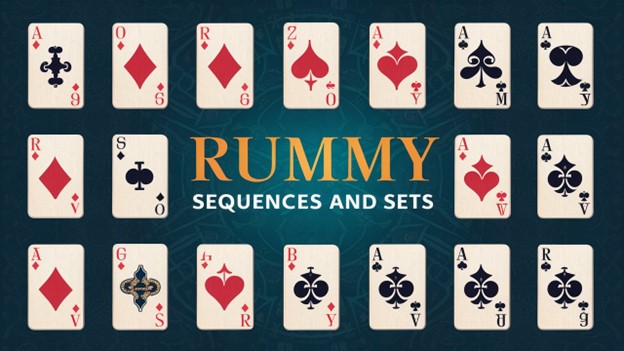Mastering the art of forming valid sequences and sets is essential for success in rummy. Whether playing traditional rummy with friends or enjoying online rummy with strangers, understanding the complexities of sequences and sets can significantly enhance your gameplay.
In this article, we’ll discuss the fundamentals of rummy sequences and sets, providing insights and strategies for mastering this aspect of the game.
Introduction to Rummy Sequences and Sets
Sequences and sets are the building blocks of a winning hand in rummy. A sequence consists of three or more consecutive cards of the same suit, while a set comprises three or four cards of the same rank but different suits.
- Sequences: A consecutive series of cards in the same suit (e.g., 3♠, 4♠, 5♠).
- Sets: Three or four cards of the same rank but different suits (e.g., 7♣, 7♦, 7♥).
Mastering the art of forming valid sequences and sets is crucial for a strong hand and, ultimately, declaring and winning. It requires a combination of strategy, foresight, and skillful card management.
What Are Sequences in Rummy?
Sequences are the backbone of a rummy game. Here’s what you need to know about forming sequences effectively:
- Number of Cards: A valid sequence requires a minimum of three consecutive cards of the same suit. There’s no upper limit on the sequence length; you can have chains of four, five, or even more consecutive cards if you’re lucky enough to draw them.
- Card Order: The order of cards in a sequence is crucial. You cannot have gaps in the sequence. For example, 3♠, 4♠, 5♠ is a valid sequence, but 4♠, 6♠, 7♠ is not because there’s no 5♠ to bridge the gap.
- Circular Sequences: Sequences don’t circle. For example, K, A, and 2 is not valid sequence in rummy.
Types of Sequences
While the core principle of consecutive cards remains the same, there are two main types of sequences to consider in rummy.
Pure Sequence
A pure sequence is a sequence formed without the use of any wild cards or jokers. It consists of consecutive cards of the same suit, such as 3♠ 4♠ 5♠ or 8♥ 9♥ 10♥. Pure sequences are essential for declaring the game and are the priority for players when arranging their hands.
Impure Sequence
An impure sequence includes one or more wild cards or jokers to complete the sequence. For example, a sequence like 7♣ 8♣ Joker is considered impure. While impure sequences are valid for declaring the game, they carry a lower point value than pure sequences.
What Are Sets in Rummy?
Sets offer another way of creating melds in rummy. Here’s what you need to understand about forming valid sets:
- Number of Cards: Sets require a minimum of three cards of the same rank but different suits. Four cards of the same rank can also form a valid set in some variations.
- Suit Variation: The key to a valid set is the matching rank, not the suit. For example, 7♣, 7♦, and 7♠ constitutes a valid set, 9♣, 9♣, and 9♠ is not a valid set.
Pure Sets
A pure set consists of three or more cards of the same rank but different suits, such as 6♠ 6♥ 6♦.
Impure Sets
Similar to impure sequences, impure sets may include one or more wild cards or jokers to complete the set. For example, a set like 9♦ 9♣ Joker can be considered an impure set.
Strategies for Combining Sequences and Sets
The true power of rummy lies in strategically combining sequences and sets. Here are some key strategies to consider:
- Prioritize Pure Sequences: Focus on forming pure sequences as they hold more value and are mandatory for declaring in many online rummy variants.
- Utilize Impure Sequences Strategically: Impure sequences can be helpful when you need to complete gaps in your pure sequences or effectively utilize jokers.
- Balance Sequences and Sets: To maximize your winning potential, aim for a balanced hand using a combination of sequences and sets.
- Keep Practicing: Online rummy platforms like Rummy.com offer practice games to experiment with forming sequences and sets in a risk-free environment.
- Prioritizing High-Value Cards: Prioritize discarding high-value cards (Aces, Kings, Queens) only if they hold no meld potential.
Examples of Sequences and Sets
Here are some examples to increase your understanding of forming sequences and sets:
- Scenario 1: You have 3♠, 4♠, 5♠, 6♣, 7♣, and 8♣ in your hand. You can form two pure sequences 3♠, 4♠, 5♠ and 6♣, 7♣, 8♣.
- Scenario 2: You hold 5♦, 6♦, 7♦, J♣, J♠, and K♦ (wild joker). Here, you can create an impure sequence 5♦, 6♦, 7♦ and a set J♣, J♠, K♦ (wild joker).
Variations in Sequences and Sets Rules
While the core principles remain consistent, some online rummy variants may vary in sequence and set formation rules. Always consult the specific game rules before playing any online rummy variant. Here’s what to keep in mind:
- Minimum Sequence Length: In some variations, the minimum sequence length might be four cards instead of three.
- Wild Cards: A few variants might introduce additional wildcards beyond the standard jokers. Understanding their specific functionalities is crucial.
- Set Limitations: Variations like Points Rummy might limit the number of sets you can include in a declared hand.
Sequences and Sets – A Key to Rummy Success
Understanding how to form valid sequences and sets is a fundamental skill in rummy. By mastering these techniques, prioritizing pure sequences, strategically utilizing impure sequences, and combining them effectively, you can unlock a new level of gameplay and enhance your chances of winning in classic and online rummy.







